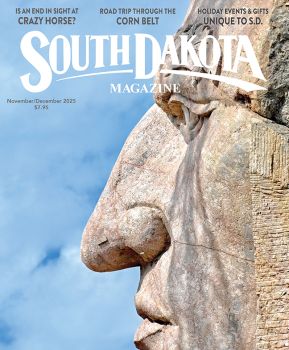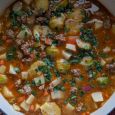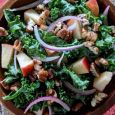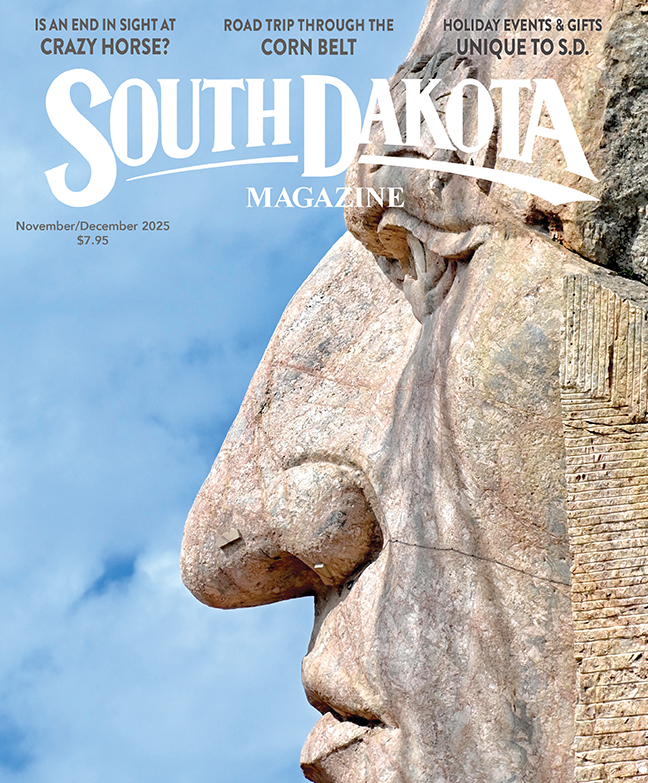The Gift of South Dakota
Subscriptions to South Dakota Magazine make great gifts!
Subscribe today — 1 year (6 issues) is just $29!
Mulled Wine, South Dakota Style
 |
| The warmth and spiciness of mulled wine makes it a favorite winter drink. |
Our South Dakota Magazine crew started a coffee house called Muddy Mo’s in downtown Yankton a few years ago. On a frigid Saturday last winter, we decided to make mulled wine, both to warm our customers as they came in from the cold and also to try something new, which was the very inspiration for the shop.
Mulled wine is warmed wine with spices added, but a quick Google search shows recipes from across the world using varied ingredients and techniques. Not one to overthink, I quickly decided to mix an affordable red wine with some mulling spices from my local supermarket. Soon after pouring the simple concoction into a crockpot, a delicious cinnamon and orange aroma wafted through Muddy Mo’s — and it quickly drew customers who were happy to weigh in on my makeshift recipe.
“This is strong, too strong for mulled wine,” observed one kindly woman, who nevertheless drank several $2 glasses. Another visitor suggested that we add honey and offered to share his recipe. Someone asked if we could mix in a little apple cider next time. I don’t remember when something on our menu inspired so much conversation and interaction among customers.
Humans have been warming wine and adding spices since the dawn of the Roman Empire. The spice worked wonders to hide the taste of inferior wine, but it was also believed to strengthen immune systems during winter. Early recipes included saffron, pepper, laurel, dates, cinnamon, cloves, nutmeg, marjoram and cardamom.
Part of the fun of mulled wine is taking the ingredients and creating your own recipe. But, to ensure better success at the coffee shop this winter, I spoke to wine experts from across South Dakota. They were happy to share their recipes, along with ideas on what makes mulled wine the perfect winter drink.
Schadé Vineyard & Winery
VOLGA
Similar to our experience at Muddy Mo’s, Nancy Schade enjoys the community that mulled wine creates. “When you make it, it just brings people together. And there are opportunities to share recipes, because everyone has a different recipe,” she laughs. Jim and Nancy Schade founded the winery in 2000, and recently passed it on to new owners Dillon and Shelby Ringling.
Nancy recommends using Schadé’s Raspberry Apple Wine for mulling. The raspberries and apples are grown in South Dakota, giving a local taste to an internationally enjoyed drink. Nancy’s recipe is simple. She uses a 1:1 ratio of the Raspberry Apple wine and apple cider. “The cider gives the finished product a fuller flavor,” she says. Next, add mulling spice packets and warm the wine and cider in a crockpot (not to a boil). The winery sells its own mulling packets, but in a pinch, you can also find them at many supermarkets.
Prairie Berry
HILL CITY
 |
| Laura Schluckebier |
Laura Schluckebier, the sales and hospitality manager at Prairie Berry, grew to love mulled wine during her time at the Hill City winery. “It’s made to share with other people,” she says. “As soon as the leaves change, people come in to have mulled wine next to our fireplace. The guests expect it.”
Mulling wine has also evolved into a family tradition for Schluckebier. “We go skiing at Terry Peak, then go home to drink mulled wine. Or we will split wood and then make mulled wine. It’s a tradition to do things outside in winter, then to share the drink. When you make it, it smells wonderful and it’s warming all around.”
Sandi Vojta, owner of Prairie Berry, became a fifth-generation winemaker at the age of 4 when she experimented with yeast and fermentation, she told us in a 2011 story for South Dakota Magazine. Her dad would take her out to pick chokecherries for wine, tying a piece of twine with a pail attached to her waist so she could pick berries with both hands.
Schluckebier recommends using Prairie Berry’s Pumpkin Bog for mulling. Made with South Dakota grown pumpkins, it’s slightly sweet with “undertones of cranberry and lemon zest.” Pour one bottle of Pumpkin Bog into a slow cooker on low heat. Add two tablespoons of light brown sugar, two tablespoons of mulling spice and orange slices. Leave on low for 45 minutes, making sure it does not boil.
After 25 years of producing internationally-award-winning wines, Prairie Berry will be closing soon. Sandi and her husband, Matt Keck, will continue selling as long as they have inventory. Pumpkin Bog was still available for purchase as this magazine went to print.
With the Wind Vineyard & Winery
ROSHOLT
 |
| Lisa Klein |
Lisa Klein, who owns With The Wind along with her husband, Jeremiah, uses their Sacred Solitude wine for mulling. Made with locally grown Frontenac grapes, this dry red is complemented by Lisa’s recipe that includes orange juice and brown sugar.
Klein says mulled wine helps her embrace winter and everything that comes with it. “I’ve spent evenings wrapping presents while having mulled wine simmering on the stove,” Klein says. “We drink it while gathering with friends. During a frigid winter, it’s such a warm thing to serve your guests. You can’t get away from winter, so you have to embrace it.”
The Kleins have operated With the Wind for over 10 years. They hold wine tastings and events at their vineyard, where they tend to over 5,000 vines.
Sacred Solitude Mulled Wine
2 bottles of With the Wind Sacred Solitude wine
2 cups orange juice
3/4 cup (or to taste) brown sugar (or substitute maple syrup or agave)
2 oranges, sliced
1/2 cup fresh cranberries (optional)
10 whole cloves
6 cinnamon sticks
- Place a medium saucepan over medium-high heat on the stove.
- Add the orange juice and granulated sugar and stir until the sugar is dissolved.
- Add the red wine and all of the spices and fruits. The spices will be whole, not ground in a container, so their flavors will infuse into the liquid.
- Reduce the heat to low and simmer the mulled wine for 30 minutes. At this point, taste and adjust the flavor as necessary. You can simmer for up to a couple hours. Garnish with cinnamon sticks, orange peel or cranberries.
Mulled Wine can be paired with many foods. In Europe, it is often served at festivals with roasted chestnuts, and it’s also common to serve with roasted meats during the holidays. We asked Prairie Berry and Schadé wineries to share their favorite recipes to make with mulled wine.
Nancy Schade’s Never Fail Apple Dessert
Mix and put in a 9x9 inch pan:
4 cups sliced apples
1 teaspoon cinnamon
1 tablespoon flour
pinch of nutmeg
3/4 cup sugar
Mix together and spread over apples:
3/4 cup oatmeal
1/4 teaspoon baking soda
3/4 cup flour
1/2 cup melted butter
3/4 cup brown sugar
1/2 teaspoon salt
Bake at 350 degrees for 30 to 40 minutes. Cool and serve with ice cream or whipped cream.
Prairie Berry Kitchen’s Classic Cheese Fondue
1/2 pound imported Swiss cheese, shredded
1/2 pound Gruyere cheese, shredded
2 tablespoons cornstarch
1 garlic clove peeled
1 cup dry white wine
1 tablespoon lemon juice
1 tablespoon cherry brandy
1/2 teaspoon dry mustard
Pinch of nutmeg
Coat cheese in cornstarch. Rub fondue pot with garlic, then discard. Over medium heat, add wine and lemon juice. Bring to a simmer. Gradually stir in cheese, melting slowly to encourage a smooth texture. Stir in brandy, mustard and nutmeg. Serve with French bread, Granny Smith apples or blanched veggies.
Editor’s Note: This story is revised from the January/February 2025 issue of South Dakota Magazine. To order a copy or to subscribe, call (800) 456-5117.










Comments